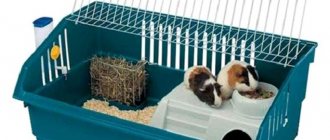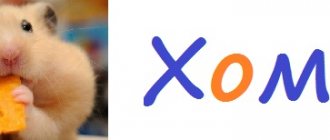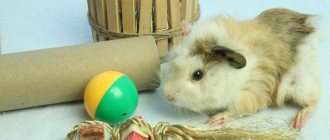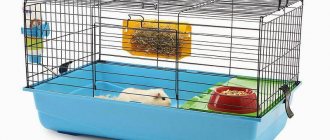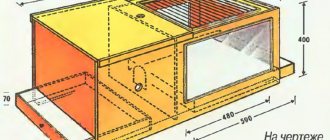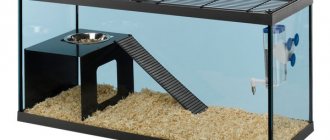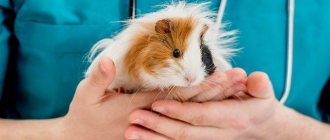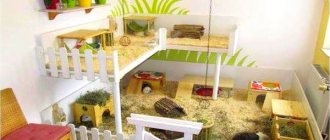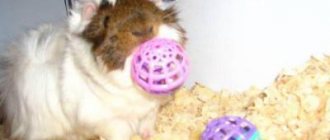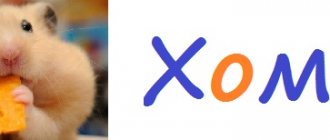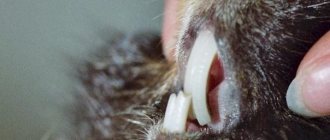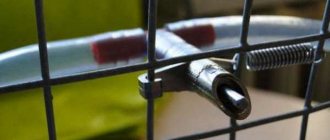Housing for guinea pigs based on a metal rack
To build a multi-story “cottage” for your pet, a metal rack is suitable.
The removable elements of this design can be easily swapped, adjusted in height, etc. If you need a larger house, it is enough to create a single structure from several racks. One end of the house is covered with plywood or other material. A metal mesh is attached to the other end and back side. It is better to make doors from plexiglass. When building a home for an animal from a metal rack, the shelves are installed upside down to create a kind of pallets.
You can easily give your pet a luxurious home by making it yourself or simply giving an old closet a second life. A properly created shelving structure is not just a comfortable house for your pet. With a creative approach to the construction of this home, it will become a real decoration of the interior.
How to set up a cage for a guinea pig?
It is not enough to make a cage, you need to equip it, creating comfortable conditions for existence for the animal. Here's what a pet might need in a pen:
- Bed
. Many people are interested in whether a guinea pig needs a house in a cage. Experts say it is needed. Here the animal can take a break from human attention. It can be made from the same plywood or sewn into a soft sleeping bag. - Drinker and feeder
. There is no need to explain why these elements are in the cage. - Hay tray
. Guinea pigs are constantly chewing on something, and they especially love fresh grass. It is better to design a special compartment for them so that the hay does not lie all over the cage. - Ladder
. It is necessary if the cage has several floors. - Toys
. Pigs especially love products like a hole or a labyrinth. You can use for this purpose a piece of ordinary plastic pipe with a diameter corresponding to the size of the animal. - Hanging accessories
- hammocks and metal balls filled with hay or vegetables and fruits.
https://youtube.com/watch?v=NV-VbfnTiV4%250D
Guinea pig bedding in a cage
Animals need a warm and comfortable covering. There are several options for checkered bedding that are especially popular:
- Rug for a guinea pig in a cage, made of polyvinyl chloride (PVC)
. Such products are sold in large rolls, which makes it easier to manufacture the desired bedding. It is easy to care for such a rug, because you just need to shake it out, wipe it with a wet cloth and you can put it back in place. It is recommended to machine wash it once a week. - Fleece liner
. This fabric is well known to parents of small children. It is soft, warm and pleasant to the body. Fleece is waterproof, and sawdust and small debris can easily get stuck in this fabric. However, if you take care of the litter and wash it often, it looks aesthetically pleasing. - Bedding made from disposable diapers
. These are sold at pharmacies or pet stores and can be used as a rug. The only condition is that they need to be changed in a timely manner.
Guinea pig cage litter
Rodent owners use a variety of fillers:
- Sawdust
. This is a lightweight, soft and environmentally friendly material that is chosen by many. This filler should not contain too rough or sharp wood chips. - Wood pellets
. Arranging a cage for a guinea pig can be done using this filler. It absorbs moisture and odors well and emits a pleasant pine aroma. It can be covered with a PVC mat and thereby obtain a thick and warm bedding. - Plain paper or newspaper
. Cheap option that requires frequent replacement. - Corn granules
. They are harmless to guinea pigs, do not cause allergic reactions and smell good, but animals can eat them, so this type of litter also needs to be covered with a rug. - Wood shavings
. It must be well dried and free of resin, otherwise the animal may be poisoned by toxins, especially if a closed guinea pig cage is used.
Guinea pig toys in a cage
There are also a lot of options here, because there are so many breeders, so many ideas.
Those interested in how to equip a cage for a guinea pig and what to offer for leisure activities should pay attention to:
- Paper bags
. Pigs happily climb inside, chew on the walls and play with these objects. - Cardboard roll from toilet paper or towels
. Depending on their size, pets can climb inside and hide there, playing with each other. - Bricks and stones
. Necessary for sharpening claws and teeth. - Old socks stuffed with straws
. Pigs can use them as a pillow. - A towel fixed on the bars
. This improvised hammock will be loved by many pets.
Pet accessories
Modern manufacturers of accessories for keeping a pet are trying to release a variety of gadgets that no one had ever thought about before. They even produce diapers for guinea pigs. And this is just one example of accessories for keeping an animal.
Did you know? Guinea pigs have been a source of meat since the ancient Incas. In many restaurants in Ecuador and Peru, even now you can find dishes from these rodents on the menu.
Additional products for caring for a guinea pig may be:
- claw stone;
- branch for chewing;
- brush for caring for fur lint;
- tunnels made of plastic pipes (with a diameter larger than the cross-section of the animal’s body);
- toys (ropes, swings, ladders);
- diapers (store-bought or homemade from fabric);
- leashes (which are used for small breed cats).
Types of cells
The stores offer a large assortment of different cages for pigs and very often novice breeders are faced with difficulties in choosing, and sellers do not always have enough knowledge to give really good advice. Often, beginners buy cages that are too small or even dangerous for pigs. Dangerous for animals include:
- Aquariums,
- Terrariums,
- Dune Cells,
- Cages for mice and hamsters,
- Bird cages.
Aquariums and terrariums
An aquarium or terrarium is not the most suitable living space for guinea pigs. The terrarium has advantages only in relation to the owner: it is easy to wash, the environment is always clean and the smell of the animal is not felt. For a guinea pig, the terrarium has only disadvantages. The main ones are poor ventilation and uncontrolled humidity. The animal is doomed to live in the fumes of its waste products, and even an open lid or side ventilation is not sufficient. Evaporation leads to increased humidity and elevated temperature, which means an increased chance of developing skin and intestinal diseases, overheating and death.
The only exceptions are hairless pigs, which the terrarium protects from drafts and temperature changes. Overheating is not as scary for them as for shaggy animals. However, breeders of hairless pigs should clean the bedding daily and wash the entire terrarium once a week, equip it with an additional heat lamp and ventilation.
Plastic containers
The dune container is also the most commonly used container for hairless pigs and requires daily and thorough cleaning. However, this model has all the same disadvantages as a terrarium - it limits the flow of fresh air, increases the risk of diseases and infection with skin parasites. Even veterinarians do not recommend keeping guinea pigs in dune containers all the time. It is more difficult to equip them with additional forced ventilation; the plastic quickly becomes dirty and bacteria actively multiply on it.
Cages for hamsters or mice
The advantages of these cages are extremely questionable, but sellers most often advise choosing these particular models - they are smaller in size, cheaper and easy to wash. And the fact that the size of a cage for mice or rats is several times smaller than what a pig needs is not taken into account. The result is stress in the animal, health problems, aggression due to confined spaces and death. The main disadvantage of such a cage is not only its size. Some breeders choose spacious cages with many holes and labyrinths. But they are designed for small rodents. The pig will get stuck in them and with a hundred percent probability will receive an injury incompatible with life.
Bird cages
They are too high, have inconvenient placement of ladders and platforms and very often lead to dangerous injuries.
Shared content
How to choose a pair
Guinea pigs are one of the most peaceful and sociable animals. Therefore, it is recommended to keep two or more rodents of the same sex at once.
You cannot house the first animals you come across together.
You need to choose a pair wisely:
- It is not worth keeping a male and a female together if you do not plan to breed animals. The boy will annoy the girl with his advances; in response, she may spray the gentleman with a stream of urine and run away.
- It is ideal to purchase two babies of the same sex at once.
- It is acceptable to place the baby with an already adult pig, which will not perceive the baby as a threat.
- Two males and a female in one cage cannot live peacefully. The males will pester the female and fight with each other.
If adult rodents are purchased, it is better to give preference to females.
Types of enclosures for pigs
In the summer, experts recommend releasing pigs onto the grass, giving them a little freedom. Ideally, summer residents will be able to do this by taking a portable enclosure with them. If you don’t have money for an enclosure, you can drive small pegs into the ground and stretch a tight mesh. Despite the simplicity of such a structure, an enclosure of this type will not protect your pet from uninvited guests. The greatest danger comes from cats, dogs and birds of prey flying past. If the pig is in an enclosure without a cover on top, it must be under constant supervision.
Enclosures have different internal designs. For the convenience of the animal, you can build tunnels and indoor labyrinths where it can hide from danger. Additions are most often constructed from balsa wood or oak. Bridges can be made from tree bark; they increase the endurance of animals. In the pen itself, you can place additional equipment in the form of toys and other accessories at the owner’s discretion. The floor of the enclosure should be equipped with linoleum or absorbent film. Pieces of an old rug will do. Do not forget that the cage needs periodic cleaning.
Do not give your animal plastic objects, feeders or drinking bowls. Your pet may chew on such objects and injure themselves on the edges of the bitten plastic. Walking for your pet can be organized using a purchased ladder.
Country type enclosure
In the summer, many owners take their pet with them to the dacha in the summer. To make the animal comfortable, you can build a special country-type enclosure. The enclosure is built according to the previously agreed method - stakes are driven into the ground and the net is stretched. You can also pull it on top for greater safety for your pet.
An aviary of a more reliable design is usually made of solid wood. From the outside it looks like a box without a top. It can be attached if you want to protect your pet from uninvited guests like birds of prey, but then you should take care of ventilation. It is distinguished by its spaciousness and proper insulation using special means. The bottom is retractable, which ensures comfortable care by the owners. The surface of the box should be treated a couple of weeks before departure with a protective agent that will prevent rotting and the appearance of various bacteria and putrefaction, and will also protect from moisture.
It is important to remember that you only need to treat the outer part of the enclosure, since the pig may begin to chew on the wood and be poisoned by chemicals. Usually the pen is left in the shade of trees, but if it starts to rain, the pet should be brought into the house
Varieties
Today, you can find various types of pet cages on sale, each of which differs in design, size and price. The most popular option is a lattice cage equipped with a high plastic tray. It's easy to put away and the wire top provides good ventilation. You can additionally attach a drinking bowl or a hammock to the rods.
The only drawback of this house is its small area.
A container, which is a plastic container that resembles a terrarium, is also considered a good option for keeping rodents of this type. The designs of the Duna brand have proven themselves to be excellent; their upper part is made of transparent plastic and is attached to the pallet. Thanks to the presence of a lattice door, the house receives ventilation. The main advantages of such a cage include the absence of debris on the floor and protection of pets from drafts. In addition, the transparent walls of the structure allow you to conveniently observe the animal.
The only thing is that some cage models do not have lattice inserts, so due to the lack of ventilation, rodents may begin to get sick.
Cages for guinea pigs may also differ in the material used. Let's look at what they are.
- Wooden. Despite the fact that wood is a natural raw material, it can quickly absorb odors and liquids. Therefore, wooden models are not the best option for keeping such fluffies. In addition, animals can quickly chew the cage and render it unusable. If the owners chose wood, then it is recommended to cover the bottom of the structure with a tarpaulin. If desired, you can make a similar design with your own hands from wood and corrugated cardboard.
- Metal. This is the best type of cage because the material is durable. Pets and exterminators do not damage such cages. Metal rods are mainly made of durable stainless steel, which is highly resistant to detergents.
- Plastic . They are quick and easy to clean and are not afraid of cleaning with household chemicals. The only disadvantage of these structures is that their walls, made of transparent material, lose their aesthetic appearance over time.
Article on the topic: How to make a house for a guinea pig with your own hands at home - drawings and photos
In addition, the cells differ in the type of construction; they can be either one-story or two-story, with dimensions of 55.5x37x64 cm.
Before choosing one type of cage or another, it is important to consider not only personal preferences, but also performance characteristics.
Guinea pig cage requirements
You can keep a pig either in a cage with a tray on which the cage itself is placed, or in a “Dune” type terrarium.
Both a regular cage and a terrarium have their pros and cons.
The main advantage of the terrarium is that, thanks to the transparent plastic sides, the area around it will always be clean - hay, food and debris will not fly. In addition, in the terrarium the animal is protected from drafts. But at the same time, it will be difficult to achieve a sufficient level of ventilation and a comfortable temperature for the pig (it can be very hot, especially in the warm season). Ordinary cages are still preferable - they have more fresh air, you can play with your pet through the bars, and it’s easy to open the door so that the pig can go out for a walk and return home. In addition, it is more convenient to equip the cage with a feeder, drinking bowl and hammock. The downside is that garbage will fly around. In addition, the pig may chew on the bars.
The cell must meet the following criteria:
1. Space
The cage should be spacious, not restricting the animal (the larger the better). The pig should be comfortable and comfortable in its home. The recommended minimum housing size for one pet is 40x80 cm. Pigs love to stand on their hind legs, so the height of the cage - 50 cm - should freely allow them to do this. Obviously, if there are several pets, a larger size is needed (90-100 cm in length).
2. Convenience and ease of cleaning
Cleaning the cage is an important point in caring for your pet, but you don’t always want to disturb it, so it should be equipped with a plastic tray that can be pulled out and put back in without disturbing the animal.
3. Safety for the pet (no sharp protrusions, chips)
When purchasing a cage, pay attention to its integrity - the absence of chips, damage, protruding rods and other possible defects that could lead to injury to the animal. There should be no gaps in which the animal could get stuck and get injured.
Design
The pet's housing should be spacious and safe, and it should be convenient for the owner to clean the cage and remove the animal from the outside. Single-story structures with solid shelves and ramps are suitable for pigs. Lattice surfaces are not suitable as paws can get stuck in them. The bottom of the device is a plastic tray, which is attached to the lattice top with special latches. The fastening must be strong so that the structure can be moved with the pet inside. If there is no room in the cage for a shelf, then the roof of the rest house can serve as its role.
So that the owner can easily reach the animal without injuring it, a wide door is needed.
It is recommended to choose a distance between the rods of about 2.5 centimeters. Such gaps will prevent the animal from getting stuck. Before use, you must check the structure for sharp corners and crevices. If they exist, they are eliminated, as it is dangerous for the animal.
The place where the pet will spend most of its time should be quiet and calm, hidden from sunlight and drafts. If a pet lives alone, then its housing is placed in a place from which the pet observes the life of family members.
What types of enclosures are there?
Enclosures can have different “interiors”. You can make some kind of tunnels and pipes so that the animal can run and hide through them. This is often made from cork oak. Guinea pigs enjoy a variety of bridges. They can be made from bark. Ceramic toys and wicker baskets can be placed in the pen.
It is better to place an absorbent diaper on the floor in the enclosure. Old linoleum will do. You can throw on pieces of an old natural rug. Don’t forget to sanitize all this in a timely manner.
You can organize a walk for your guinea pig using a fence purchased from a pet store.
What should a home be like for a guinea pig?
When choosing a home for a pet, pay attention to several factors. Firstly, the house should be spacious
The pig should fit there freely. The opening for entry and exit must allow the animal to pass through, eliminating the possibility of getting stuck.
Secondly, the use of toxic materials, paint or varnish is unacceptable. A rodent can taste its home and become poisoned.
Thirdly, protruding screws or nails are not allowed in the design of personal housing. It is also recommended to check for cracks. There should be no holes in the house in which the pet’s paw could get stuck. It is not recommended to choose products with sharp parts, such as pointed turrets. They can injure the pig.
Fourthly, the air in the home should be well ventilated. To do this, several holes are made in the house. An animal can use them to enter and exit its home, or as windows.
What to feed your guinea pig and how often?
Overseas pets are unpretentious in nutrition. They eat vegetables, greens, grains, that is, everything that herbivores love. If you are not sure what to feed your guinea pig, we recommend Chinese cabbage, carrots and celery. They also eat exotic fruits, but such food can lead to the death of the pet, so it is better to avoid them.
Pigs eat almost constantly, with short breaks for sleep and play. But these rodents cannot be fed at every request, otherwise they risk becoming a victim of obesity. It is enough to replenish the feeders 2 times a day, preferably at a certain time. At the same time, there should always be clean drinking water in the cage. Chalk can be used as a dietary supplement; pigs eat it with great pleasure.
How to choose and where to place?
Before getting a guinea pig, you first need to purchase a cage to house it. Since there is a chic assortment of pet houses on the market, it will be difficult to make the right choice in favor of one model or another.
When purchasing cells, experts recommend paying attention to the following parameters:
- Design size. Guinea pigs need horizontal space and there should be plenty of it. The larger the area of the house, the more freely the animal will be able to move. In cramped cages, the rodent will begin to feel sad and sick. Since on average it is necessary to allocate at least 70 cm2 per pig, the best option would be to purchase a cage measuring 75x90 cm. For two individuals, therefore, a larger structure will be required.
- Free access to cleaning and ventilation. Since the furry house should be cleaned and washed regularly, its design should have removable elements.
- Quality. All locks, doors and bars must be secure. Metal cages are a good choice for keeping guinea pigs; they are the most durable. A combined structure made of plastic and metal rods is also suitable for comfortable housing.
- Form. Rectangular designs are best suited for pigs; it is not recommended to buy multi-level and tall models.
- Ability to fold and disassemble. Prefabricated models are universal because they are easy to store and transport.
- Distance between rods. They should be at such a distance from each other that the animal cannot stick its head through. The ideal option is 2.54x10.2 cm.
- Compliance with the design of the room. Today, manufacturers produce various cell models that differ in color and decor.
After the rodent cage has been purchased, the only question left is its arrangement and selection of a place for installation. It is worth immediately noting that the position of the cell is of great importance. For example, it is not recommended to place the house in or near the kitchen. This is due to hygiene standards
Therefore, in order to correctly locate the rodent’s habitat, it is important to take into account several factors.
- Microclimate of the room. Air temperature and humidity should always remain constant. The animal feels comfortable in a temperature range from 18 to +22 degrees, while the optimal humidity level is considered to be at least 40%. Since in winter there is often a temperature difference in the rooms, the cage cannot be placed on the floor; a bedside table or table is suitable for it. It is also not recommended to place houses with guinea pigs near doors and windows, since drafts are possible.
- Activity. This type of animal loves to be constantly close to people and requires special attention and care from its owners. Therefore, in order not to leave your pet alone, you can place it in the living room. But in this case, you will have to provide in advance the presence of a shelter in the cage where the rodent can hide when it gets tired.
- Noise. Guinea pigs have acute hearing, so their houses should not be placed near sources of loud sounds (TV, stereo system).
- Protecting your pet from other animals and children. It is advisable to place the cage in such a way that you can watch the kids play with the pet. If there are cats and dogs in the house, it is best to place the houses on a hill.
Some guinea pig owners arrange housing for their pets not in the house, but outside, under a special canopy. Such structures must be protected from the penetration of predators and bad weather. If the rodent lives in an apartment, then in the summer it is recommended to take it with you to the dacha. Fresh air and an assortment of green complementary foods will bring your fluffy a lot of pleasure and joy. In this case, the cage should be placed in a place where there is no extreme heat, dampness, cold, and there is protection from direct rays of the sun and rain.
There are also certain restrictions on the placement of cells, so they cannot be kept in the following places.
- On the windowsill on the sunny side and under the glass roof in the greenhouse. It will be very hot for the animals there.
- In the garage. Exhaust gases constantly accumulate in this room, which are poisonous and dangerous not only to the health of the animal, but also to humans.
- In unheated rooms. This type of pet should not be overheated or overcooled. It is also not allowed to warm the room where the pig is located with kerosene gas or a kerosene lamp. These heat sources emit many harmful gases.
and care
Choosing a cage, location and accessories for it
The guinea pig is an unpretentious pet, keeping and caring for which is quite simple. The most convenient size of a wire cage pallet for keeping a pair of guinea pigs at home is 120x60 cm. Sawdust or other filler from a pet store is poured onto the pallet in a layer of 3 - 5 cm. When choosing granulated sawdust, mix them with wood, otherwise the pigs will develop calluses on paws.
The height of the cage should be from 30 to 50 cm, which will give the animals the opportunity to stand on their hind legs. You can stack one cage on top of another to save space. The cage should be placed in a bright place, but without direct sunlight. It is very important to protect animals from drafts. The optimal average daily temperature for keeping a rodent is 18 – 20C˚. In summer, animals can be kept outdoors, for example in a garden, protected from light.
Many people prefer a cage to a closed terrarium. This is due to the fact that the filler flies from the first over a long distance. The terrarium protects well from drafts, but it is more problematic to secure a hammock, salt stones, drinking bowl and other accessories in it. On the other hand, the cage is more breathable, and it is easier to take the animal out for communication. Required accessories for the cage:
- drinking bowl,
- two feeders,
- flat pebble for grinding claws,
- salt stone or mineral salt wheels,
- tree branches,
- hammock, ladders, shelves, manholes (optional).
Pet stores offer houses for rodents made of different materials: bark, wood, plastic. Although, experts do not recommend buying a house for kevi. The pet may become less tame and sociable; it will spend all its free time in solitude.
The cage is cleaned 1-2 times a week. Usually pigs go to the same place to relieve themselves, so you can teach them to relieve themselves in a special tray and change it daily.
Shared content
Guinea pigs feel calm and comfortable only in the company of a fellow partner. This is inherent in them by evolution and is due to the life of caves in the wild. It is easier to keep two or more females in one cage. If you have two boys, they should be provided with enough territory, food and water to avoid quarrels. As a last resort, the animals can be separated by a thin wire partition, through which they will see each other and sniff. opposite-sex couples should not be practiced in order to avoid uncontrolled reproduction.
Members of the Federal Association of Medical Practitioners (Germany) have proven that 50% of Kevi's behavior comes from social communication with their own kind. In many European countries (Germany, Holland, Austria) it is prohibited to keep social animals alone. This includes the Hawaiian pig.
Walks
If there is enough space in the cage and there is an opportunity to “have fun” (hammock, ladders and other attractions), then walking your pet is not necessary. But if the cage is too small or there is nothing in it except a feeder and water bowl, you can periodically organize walks for the pigs. To avoid such troubles as chewed furniture or damaged carpet, it is better to build a special fenced enclosure. You can let pigs out to run around in the fresh air, but they need to be closely monitored so that they don’t run into some hole or become prey to a larger animal.
Dental care
How you care for your guinea pig's front teeth is very important. They require special attention. Like all rodents, they grow throughout their lives and require constant grinding. Usually the animals themselves grind off the excess on the young branches of fruit trees, but sometimes they need help. The incisors can grow to a length that can pierce the tongue or gums. It also happens that kevi have an incorrect position of their incisors from birth. In this case, you have to contact the veterinarian once every 3-4 months so that he can shorten the overgrown teeth.
Ear care
It is enough to wipe the ears with a clean, dry cloth once every few weeks. If they have a foul odor or discharge, this could be a symptom of an ear parasite. You should consult a doctor as quickly as possible.
Eye care
If discharge or crusts appear in the corners of the eyes, they are carefully removed with a cloth soaked in boiled water. Excessive tearing or redness of the eyelids symbolizes eye disease and requires immediate examination by a specialist.
Nail care
Nails need to be trimmed from the age of 1 year. Do this 1 – 2 times a year. For cutting, use a sharp nail clipper to trim the nails of cats or small breeds of dogs. To avoid injuring your pet, first read on the Internet how the procedure is carried out. You can contact your veterinarian for professional help. A damaged blood vessel passing through a claw takes a very long and painful time to heal. The wound can cause infection and blood poisoning.
Grooming
For short-haired and rosette-haired individuals, it is enough to brush them 1 – 2 times a week. Every time you hold a pig in your hands, a small amount of hair remains from it. This is the norm. Just like the fact that there are small bald patches behind the rodent's ears.
Long-haired breeds are brushed daily. First with a long-tooth comb, then with a soft brush. To make combing easier, you can lightly moisten the fur with water from a spray bottle. Matted wool that cannot be untangled is trimmed with sharp scissors.
Bathing
Animals are bathed only in cases of extreme necessity: if the fur is dirty in the ground, the animal has had diarrhea, etc. A shallow plastic bowl is suitable for bathing. Water is poured into it to a level of 3–4 cm from the bottom. The water temperature should not be higher than 38C˚. The pig is bathed using baby shampoo for little ones or a special veterinary shampoo for rodents. When swimming, protect your ears, eyes and nose from water. The bathed animal should be wiped dry with a warm towel. Long-haired individuals should be dried with a hairdryer using warm, not hot air. A freshly bathed pet is very sensitive to drafts and cold temperatures.
Materials
Three types of materials can be involved in the production of pig housing.
- Plastic.
Durable material from which pallets are made. It is easy to clean and does not react with liquids. But it scratches easily and loses its appearance over time.
- Metal.
Grates are made of stainless steel. They are durable, do not absorb odors and are easy to clean.
- Tree.
Partitions for the enclosure and shelves are made from wood. This material is safe, but it has disadvantages. Wooden parts absorb odors and are difficult to clean. Pets wear down their teeth on wooden objects, which leads to an unpresentable appearance or complete disappearance of the wood.
A tarpaulin is used as flooring in the pet's cage. It needs to be caged to protect surfaces. This material does not absorb moisture, is easy to clean and takes up little space during storage.
Home improvement
Feeder
Feeders are divided into several types:
- floor;
- retractable;
- external.
The main requirement for the design is stability. If the animal rests its paws on the container, it should not tip over. The ideal option is a glass or ceramic feeder. A plastic product will also work, but it is not reliable. It is easy to move, turn over, or simply chew on it. Metal vessels are more reliable in this regard.
Sennik
For hay and green fodder you need a separate feeder or hay barn. Hay is the main source of protein in a rodent's diet. It must be present in the cell. The sennik will not allow the pig to scatter the food and get it dirty.
Drinking bowl
An ordinary bowl will also work as a drinking container. But an automatic drinker is much more convenient; it will provide the animals with constant access to drink, protect the water from contamination and prevent the animals from spilling liquid on the bedding. Plastic and glass containers are recommended for guinea pigs.
Filler
There are several options for cage bedding:
- Wood granular filler. Economical, but noisy option, absorbs moisture well.
- Sawdust. They absorb moisture and odors worse than granules, but are widely used because they are softer and do not require additional coating.
- PVC mat. It is convenient to lay on top of granules or sawdust.
- Corn filler. Hypoallergenic, but moisture can cause mold to form on it.
- Paper filler. Absorbs moisture well, absorbs odors poorly.
- Diapers. They can be laid under the filler, this will make cleaning easier.
- Fleece. It is aesthetically pleasing and pigs like it because it is very soft. It does not absorb moisture, but passes it through itself, remaining dry. You need to put another type of filler under the fleece.
The layer of litter should not exceed 5 cm. The filler should be changed as it gets dirty.
House
Rodents need a place to hide and rest. The houses are made of plastic, bark and wood. It is better to give preference to a bark shelter. The pig can grind its teeth on it.
Cell location
When choosing a place for an animal’s home and installing a cage, you need to remember:
- The cage should be at least 50 cm away from heating devices.
- The cage moves away from the wall approximately 30 cm.
- Cold air flows from the air conditioner should not reach the pet.
- It is not recommended to install the cage in the kitchen;
- Electrical appliances and equipment should be kept away from the animal.
Arrangement of the cage
Inside the cage, you can make various elevations and shelves to provide your pet with the opportunity to move more. All elevations, as well as the second floor, should have a ramp convenient for the pig. It is made from a thin board or plywood, onto which pieces of slats are glued at regular intervals.
Safe ladder for guinea pigs.
To entertain the pigs, you can put wooden toys in the cage - blocks and figurines for gnawing. Some pigs like to roll balls; a regular tennis ball or one made of hard rubber will do.
It is important that the size of the ball is large enough, otherwise the pet will be able to chew it. Hanging hammocks for lying on are very popular among pigs.
They can be sewn from thick fabric or a towel; small carabiners are used for fastening.
Also, a house must be placed inside the new home, which the rodent will use as a permanent shelter. In a large cage there should be several such houses, preferably based on the number of animals living in it. You can make a shelter yourself from wood or plywood, or purchase a plastic version at a pet store. It is also recommended to buy a hanging drinker, feeder and hay barns - these items are difficult to make on your own with sufficient quality.
What a cell should be like: basic requirements
The most important thing is space. Your guinea pig should have room to run around and do its business. Pet stores offer a large selection of cages to help you decide.
The cage must have a lid. It is desirable that it be removable. This makes it easier to interact with your pet.
Guinea pigs have quite sensitive paws
For this reason, special attention should be paid to the pallet. The mesh bottom will not suit them
Give preference to a solid pallet that will resemble a regular floor. It can easily be covered with hay or other soil.
It is advisable that the pallet be removed. This makes cleaning the cage easier. This also needs to be done regularly.
Space and size
Immediately notice the large and spacious cells. Double-decker cages are more suitable for hamsters
As for guinea pigs, they will prefer vertical, spacious cages, which are usually purchased for rabbits.
By nature, guinea pigs move around quite a lot. When free, they have to walk kilometers to get food. It is for this reason that they need movement. Otherwise, the animal will suffer from obesity and other diseases.
It is advisable to keep these animals in comfortable home enclosures. If you have a private house, then make a small fence for the guinea pig on the site. This way she can run around on the grass.
The minimum size of a cage for one pig should be 60x40 cm. Try to let your guinea pig out of the cage every day so that it can run around more and be free.
Material of manufacture
The most common materials for making cages are metal, plastic and wood. Some people prefer to place the guinea pig in an aquarium.
Metal cages are the most durable. The rods are made of stainless steel, which are durable. Detergents also do not negatively affect quality.
The plastic tray is easy to clean. It is also resistant to all types of detergents. The main drawback is scratches.
Wooden cages are a poor solution. They quickly absorb moisture. For this reason, there may be an unpleasant odor that is almost impossible to remove. The sharp teeth of a guinea pig will soon render this dwelling unusable.
Design
First of all, a cage for a guinea pig should be spacious, comfortable and not dangerous. Only in this case will your pet feel good throughout its life.
The pallet must be well secured. In this case, it is convenient to move the cage to another place without the risk that it may fall apart and the animal will be injured.
The distance between the rods should be large. But it is worth considering the fact that the pig can easily stick its head in and get out. This cannot be allowed. For this reason, try to find the optimal size between the rods.
As for the location of the cage, it is better to choose a place that will be located on a hill. The fact is that guinea pigs are curious creatures. They love to watch everything that happens. The pet will also be calm if the owner is in sight.
Animal safety
When choosing housing for your pet, first of all, take care of safety.
Choose a cage so that the pallet is continuous. In this case, the pig is not at risk of injury to its paws, which are quite tender.
There are several types of cells
How to make it yourself
A homemade cage has a number of advantages:
- Use of environmentally friendly materials.
- Less money is spent on consumables.
- The design and dimensions of the device are suitable for the individual parameters of the room in which the pet will live.
Recommended dimensions for the base on the short side are 70 cm, on the long side 100 cm. For two pets, the long side should be at least 140 cm, for three – 170 cm, for four – 210 cm. The height of the roof should be at least 40 cm.
To make a cage you will need:
- Knife;
- cardboard;
- a simple pencil;
- ruler;
- lattice;
- scotch;
- screeds.
Production begins with markings on straightened cardboard. A base with the required parameters is drawn on it, leaving an additional 15 centimeters on each side. Using a knife, make shallow cuts along the lines of the drawing. Then the cardboard is covered with tape, gluing the strips tightly to each other or overlapping. Then the sides are raised at the cardboard base, which must be secured with tape.
The pre-prepared lattice is cut according to the parameters of the base and assembled, fastened with ties. The resulting structure is inserted into a cardboard base. Housing is ready.
It is recommended to choose the width of the grille gap at 2.5 centimeters. This will allow the paws not to get stuck, but it is also impossible for the animal to crawl through such a gap.
It is recommended to equip your guinea pig's cage with partitions, shelves and other devices for entertaining the animal. Shelves and ramps must be made of wood. Stoppers need to be attached to the edges of these elements so that the pet understands where the surface ends.
Toilet training a guinea pig
Choosing a place for the toilet
First, you need to observe your furry rodent for some time to identify the most popular place for him to go to the toilet. Observation is usually necessary for two to three days.
So, when cleaning the cage, pay attention to where the most animal waste products accumulate. This is exactly the place that will become the future territory of the tray.
This tactic will greatly increase the chances that your guinea pig will go to the toilet in the place you choose.
Toilet training in one place: recommendations
Careful observation by the owner of the behavior of the furry pet will make it possible to toilet train the guinea pig as quickly as possible. By the way, most of these individuals begin to use the tray on their own if it is located in a place they have already determined. If this does not happen, then you can put some dry grass in the tray. This will be a kind of incentive for the rodent to want to get inside. You can also add two or three granules saturated with the smell of feces to the tray.
Some guinea pigs relieve themselves in the same place where they eat. In this case, the animal owner needs to put some food inside the tray - this way the animal will get used to the new toilet.
Reproduction
Preparing for pregnancy
Despite the fact that the animals reach sexual maturity early, experts recommend breeding them at the age of at least 10 months. When choosing a pair, give preference to individuals of the same breed and age category. Future parents should not be related. Obese individuals should also be excluded. A week before the expected mating, increase the amount of vitamin E in the animals’ diet.
It is advisable to plan a future pregnancy so that fertilization takes place no later than November, then the female will have time to feed her offspring before the spring molt. Otherwise, the combination of lactation and molting can be disastrous for the female, weakened after pregnancy. For the same reason, it is not recommended to cover females more than three times, and rare breeds that are difficult to care for and breed, twice a year.
Estrus in guinea pigs lasts 2 days and repeats every 12 to 20 days. The most favorable period for fertilization is the first 12 hours. It is not difficult to notice the pig’s readiness to become a mother; she takes a characteristic pose: she raises her back, spreading her legs and standing motionless. Males are almost always ready to mate.
The fertilized guinea pig is placed in a separate cage. If the next heat does not occur, then this indicates pregnancy, which will last about 10 weeks. Multiple pregnancies may result in earlier births.
Toxicosis in guinea pigs
So-called toxicosis can become a big problem during pregnancy. This is a painful condition that is typical for many individuals in the last weeks of pregnancy or the first days after childbirth. Often this condition leads to the death of the animal. Manifestations of toxicosis:
- Muscle cramps.
- Loss of appetite or complete refusal to eat.
- Profuse drooling.
- Tousled, dull fur.
The causes of toxicosis are poor nutrition, lack of water or vitamins, stress or multiple pregnancy. It is necessary to isolate the pregnant female from all these factors and provide her with special care.
Caring for a pregnant female
- Calm walks 1 – 2 times a day.
- Stable temperature and humidity in the room.
- in a cage with an area of at least 1200 - 1500 cm2.
- No stress - it is not recommended to handle the pig (it can cause miscarriage), pet it, or clean the cage often or for a long time.
- A varied diet - in the first half of pregnancy, the feed rate is increased by 1/3, in the second half - by 2 times.
- In addition to drinking water, they offer rosehip infusion, milk and tomato juice.
- Mineral and vitamin supplements in food (according to the recommendation and dosage of a veterinarian).
- Installation of a house in a cage with a nest made of fresh hay.
- For hygiene purposes, long-haired females need to be trimmed a few days before giving birth.
Childbirth and baby care
Childbirth is usually quick and uneventful, lasting no more than 30 minutes. Newborns are born sighted, hearing and with developed incisors. Weight ranges from 50 to 140 g. A litter contains on average 3 – 5 individuals. The cubs grow quickly, and on the 2nd - 3rd day they begin to eat food familiar to adults. By one month they become full-fledged guinea pigs, which can be separated from their mother.
It may happen that the mother dies during childbirth or after it from toxicosis. Then the best option would be to place the offspring with another female, since it is better for the babies to be among relatives. It is usually possible to feed orphans with diluted dry cream from a pipette. Be sure to provide the little ones with access to eat the droppings of adult pets. If by the 17th – 20th day of life the weight of the cubs has doubled, then we can assume that they are saved and are developing normally.
Unfortunately, non-viable babies born weighing up to 40 grams must be disposed of immediately. It is almost impossible to get out of them and, even if possible, the individuals will be too weak and sickly to live a full life.
How to arrange it?
Objects inside the home should be well attached to the walls or located on the floor. Inside the cage it is necessary to place a drinking bowl, a feeder, a tray for hay, toys, and wooden sticks. It is also necessary to provide the animal with a place of privacy.
With the help of a drinking bowl, the individual will not splash water onto the litter and will not be able to wet itself. The volume of the drinking bowl may depend on the number of pets inside the cage. If there are a lot of animals, then you can use several small drinking bowls.
There must also be a food area inside the individual’s home. It is necessary to purchase several feeders to sprinkle different types of feed. Green, juicy and tough food should be placed in different feeders.
A rodent that lives at home needs conditions similar to natural ones. The pet needs rough materials so that it can grind down its teeth. You need to put twigs inside the cage, but you shouldn’t put coniferous branches. Branches that have large bones inside the fruits must be dried in advance. You can also put a mineral stone inside the cage.
You can place hanging accessories as they will not cause injury to your pet if they are installed and secured correctly. For example, it is worth taking a closer look at hammocks on which sea pets can relax.
The animal is shy and modest. Next to caring people, the individual will become more sociable and bolder. But your pet still needs an area so that he can have some privacy. Inside the cage you should arrange a secluded corner, for example, a house.
If there are many rodents inside the cage, they will fight for it. Instead of a simple house, you need to put up a canopy or fence the entire cage with good material. Another option is to use a pipe made from compressed hay.
If a guinea pig is constantly hiding inside the house, then it will be impossible to tame it, since inside it the animal may feel isolated and cannot see people. In order for the pet to get used to the person, the house needs to be temporarily replaced with a handful of hay.
You should buy toys for the animal so that your guinea pig can have some fun. With the help of toys, your pet will be able to quickly explore the entire territory of the cage. In order for the animal to move more, you need to constantly change toys.
If you put a ball of hay in a cage, many rodents will be able to pull the straws out of it. But this design will not be convenient for eating. You can put both a special tray and a ball.
These pets feel comfortable in an area that looks like a hole. For this reason, it is necessary to purchase toys that are shaped like a pipe. If several animals live inside the cage, then you need to purchase several pipes. Pipes can serve as a shelter if pets conflict with each other. Also, pipes and labyrinths can make your pet’s life more interesting.
The animal can become interested in various labyrinths for a long time. The main thing is that the rodent is active, as this has a good effect on the pet’s health - it will not become obese.
To learn how to make a cage with your own hands, see below.
How to take care of your teeth
Guinea pigs, like other rodents, have incisors that grow throughout their lives, and to prevent them from causing health problems and injuries, they must be constantly ground down. Usually pets do an excellent job of this task without outside help. You only need to provide the animal with everything it needs: hay, grass, hard vegetables, delicacies-spikelets on a solid base. There must be chalk or mineral stone in the rodent's cage. It is needed not only for grinding teeth, but is also a source of calcium, a microelement necessary for strong bones and teeth, and good health in general.
You can also offer the rodent branches of fruit trees, peeled from the bark: apple trees, apricots, pears, etc. For many pets, gnawing on sticks is also an exciting pastime.
If you give your guinea pig only soft food, its teeth will begin to grow rapidly and will interfere with eating and hygiene. If this happens, contact the clinic. Veterinarians will trim your pet's teeth to the desired length and tell you how to avoid this problem in the future.
Instructions for making a fabric house
A fabric tent must have a metal frame base. The metal mesh is bent and covered with a fabric cover. It is recommended to use nylon or fleece. Nylon is easy to clean. Your pet will love fleece for its softness and warmth. Cardboard is sometimes attached to the mesh. These are the future roof and side walls of the house. You can use another piece of fabric as the back wall. Fleece or other bedding is placed at the base of the fabric tent. The fabric tent has many color options, is lightweight and easy to clean. But this option is short-lived, since the animal can chew it off. And then you will have to re-cover the structure with fabric.
What does a guinea pig need?
Rodents are unpretentious, but this does not mean that any living conditions are suitable for them. There are certain requirements for keeping animals at home, which relate not only to the home itself, but also to its equipment.
Cage or rack
To keep a guinea pig you need a cage. It should be spacious so that the animal does not live in cramped conditions. It is recommended to choose a cage equipped with a plastic tray - this design is much easier to clean.
You can save free space without reducing the space of the pig’s home using a two-story shelving cage. This option is also suitable if there is more than one animal.
If you were unable to find a suitable structure in a pet store or its cost does not fit into your budget, you can easily make both a cage and a rack yourself.
Aviary
If possible, it is worth purchasing or creating an enclosure for pigs with your own hands. The spaciousness of such a home is incomparable to any cage - freedom of movement for the animal is guaranteed. The enclosure can be divided into separate zones - catering unit, playroom, bedroom, etc.
Enclosures (wire or plastic) are also used for walking pigs outside during the warm season.
House
Regardless of what the main dwelling will be (cage, shelving or enclosure), you need to place a small house or other shelter inside it, where the animal can retire if desired. If the installed “shelter” has a flat roof, the pet will be able to use it as an observation tower - climbing onto the roof, it will observe from above what is happening around.
Filler
Filler plays an important role in maintaining cleanliness and comfortable conditions in your pet’s home. Recommended choices are corn pellets or sawdust. These fillers are characterized by high absorbency and safety for animals. It is worth noting that cat litter should not be used under any circumstances for pigs to live in.
Drinking bowl
During the day, rodents consume different amounts of drink - this is due to the content of juicy components in the daily food. Nevertheless, the drinking bowl with which you need to equip the animal’s home should always be filled with fresh water - filtered or clean boiled. As drinking bowls for guinea pigs, only hanging-type devices with a metal ball at the end are used.
Feeder
The pig's menu includes both dry and juicy ingredients. To prevent them from mixing, it is worth placing two bowls in your pet’s cage - pour grain mixtures or granulated food into one, and put berries, chopped vegetables and fruits into the other.
Both feeders must be stable, otherwise the rodent will overturn them. The animal can easily chew plastic bowls, so it is better to use feeders made of more reliable materials. Ceramic bowls work well - they are heavy and durable. You can also use metal ones, but to prevent the animal from knocking them over, you should attach them to the bars of the cage.
Hay holder
The pigs' diet is based on hay, so the animal should have a lot of it. To ensure that your pet always has access to hay, it is necessary to equip the cage with a special hay holder or hay rack. It is better to choose suspended structures - this will prevent animals from trampling or dirtying the hay.
Pet stores sell models of kennels made of metal and plastic. If desired, you can build a holder yourself from fabric, wood or plastic. The design is simple, the main thing is that the pet can freely remove bundles of hay from the holder.
Carrying
Fearfulness is one of the character traits of guinea pigs; they do not tolerate the road, unfamiliar places, etc. To minimize the stress of the rodent during transportation, you need to purchase a carrier for your guinea pig. It will be needed when delivering the animal home from the breeder or from the store, and subsequently to and from the veterinarian.
You can use an ordinary cardboard box with pre-made holes as a carrier so that your pet does not suffocate. But it’s better to immediately buy a real plastic carrier.
Housing and its possible options
Guinea pigs are rather timid and modest animals. Living with an attentive owner, the animal will become sociable and courageous, but one way or another, it must have room for its own loneliness. The house will be able to cope with the task perfectly.
Highly qualified specialists whose activities are aimed at breeding and keeping guinea pigs believe that it is the house that can act as an obstacle in the process of taming the animal. Located inside it, the pig feels protected. In order for an individual to quickly get used to a person, it is worth replacing the house with a handful of filler for a certain period of time.
